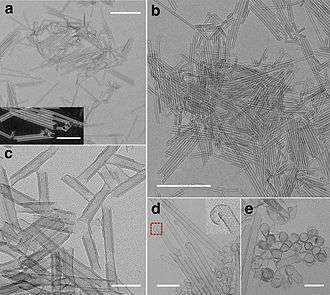Cobalt(II) hydroxide
| Red cobalt(II) hydroxide | |
| Blue cobalt(II) hydroxide | |
| Names | |
|---|---|
| IUPAC name
Cobalt(II) hydroxide | |
| Other names
Cobaltous hydroxide, cobalt hydroxide, cobaltous hydrate | |
| Identifiers | |
| 21041-93-0 | |
| 3D model (Jmol) | Interactive image |
| ChemSpider | 8305419 |
| ECHA InfoCard | 100.040.136 |
| PubChem | 10129900 |
| |
| |
| Properties | |
| Co(OH)2 | |
| Molar mass | 92.948 g/mol |
| Appearance | rose-red powder or bluish-green powder |
| Density | 3.597 g/cm3 |
| Melting point | 168 °C (334 °F; 441 K) (decomposes)[1] |
| 3.20 mg/L | |
| Solubility product (Ksp) |
1.0×10−15 |
| Solubility | soluble in acids, ammonia; insoluble in dilute alkalis |
| Structure | |
| rhombohedral | |
| Thermochemistry | |
| Std molar entropy (S |
79.0 J·mol−1·K−1[2] |
| Std enthalpy of formation (ΔfH |
-539.7 kJ·mol−1 |
| Hazards | |
| Safety data sheet | Oxford University |
| EU classification (DSD) |
|
| R-phrases | R20 R21 R22 R36 R37 R38 R43 |
| S-phrases | S24 S26 S36 S37 S39[3] |
| NFPA 704 | |
| Related compounds | |
| Other anions |
Cobalt(II) chloride Cobalt(II) bromide Cobalt(II) iodide |
| Other cations |
Iron(II) hydroxide Nickel(II) hydroxide Copper(II) hydroxide |
| Except where otherwise noted, data are given for materials in their standard state (at 25 °C [77 °F], 100 kPa). | |
| | |
| Infobox references | |
Cobalt(II) hydroxide or cobaltous hydroxide is the chemical compound composed of cobalt and the hydroxide ion with the formula Co(OH)2. It occurs in two forms, either as a rose-red powder, which is the more stable of the two forms, or as bluish-green powder.[1][4] It has the brucite or cadmium iodide crystal structure.[5]
Uses
Cobalt(II) hydroxide is most commonly used as a drying agent for paints, varnishes and inks, in the preparation of other cobalt compounds, as a catalyst and in the manufacture of battery electrodes.[1]
Reactions
Cobalt(II) hydroxide is precipitated when an alkaline hydroxide is added to an aqueous solution of Co2+ ions:
Cobalt(II) hydroxide decomposes to cobalt(II) oxide at 168 °C under vacuum and is oxidized by air to form cobalt(III) hydroxide, Co(OH)3.[1] The thermal decomposition product in air above 300 °C is Co3O4.[6][7]
Like iron(II) hydroxide, cobalt(II) hydroxide is primarily a basic hydroxide, although it does form the weakly acidic reddish hexaaquacobalt(II) ion, [Co(H2O)6]2+, in acidic aqueous solutions. In strong bases, cobalt(II) hydroxide accepts additional hydroxide ions to form dark blue cobaltates(II) [Co(OH)4]2− and [Co(OH)6]4−.[5]

References
| Wikimedia Commons has media related to Cobalt(II) hydroxide. |
- 1 2 3 4 Patnaik, Pradyot (2003). Handbook of Inorganic Chemical Compounds. McGraw-Hill Professional. p. 243. ISBN 0-07-049439-8. Retrieved 2009-03-27.
- ↑ Lide, David R. (1998). Handbook of Chemistry and Physics (87 ed.). Boca Raton, FL: CRC Press. p. 513. ISBN 0-8493-0594-2.
- ↑ "Safety (MSDS) data for cobalt (II) hydroxide". Oxford University. Retrieved 2009-03-27.
- ↑ Lide, David R. (1998). Handbook of Chemistry and Physics (87 ed.). Boca Raton, FL: CRC Press. p. 454. ISBN 0-8493-0594-2.
- 1 2 Wiberg, Nils; Wiberg, Egon; Holleman, A. F. (2001). Inorganic Chemistry. Academic Press. pp. 1478–1479. ISBN 0-12-352651-5. Retrieved 2009-03-27.
- ↑ Jayashree, R. S.; Kamath, P. Vishnu (1999). "Electrochemical synthesis of a-cobalt hydroxide". Journal of Materials Chemistry. 9 (4): 961–963. doi:10.1039/A807000H.
- ↑ Xu, Z. P.; Zeng, H. C. (1998). "Thermal evolution of cobalt hydroxides: a comparative study of their various structural phases". Journal of Materials Chemistry. 8 (11): 2499–2506. doi:10.1039/A804767G.
- ↑ Ni, Bing; Liu, Huiling; Wang, Peng-Peng; He, Jie; Wang, Xun (2015). "General synthesis of inorganic single-walled nanotubes". Nature Communications. 6: 8756. doi:10.1038/ncomms9756. PMC 4640082
 . PMID 26510862.
. PMID 26510862.
